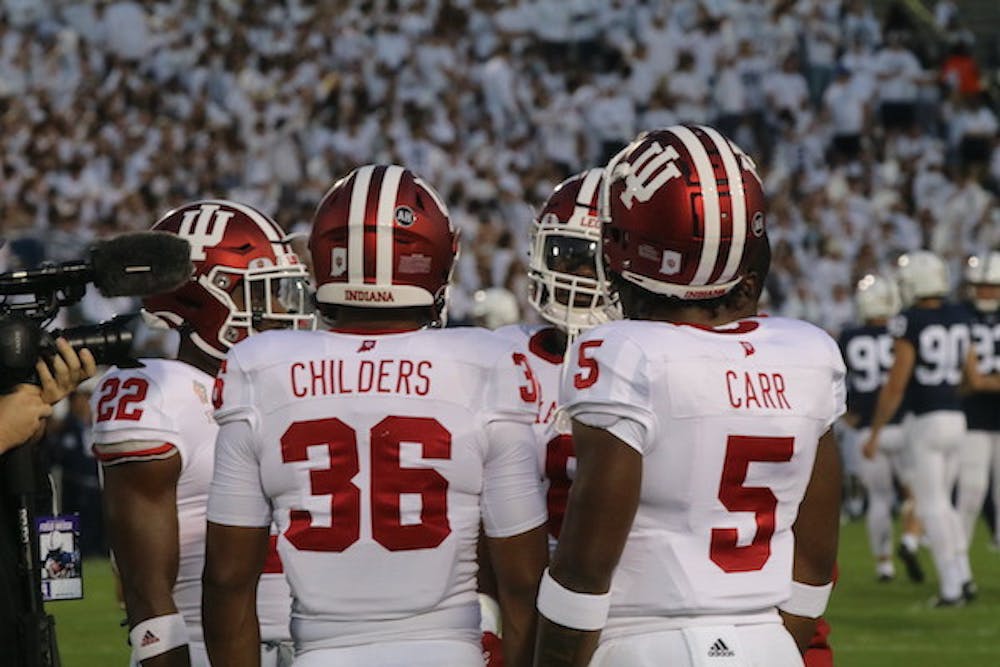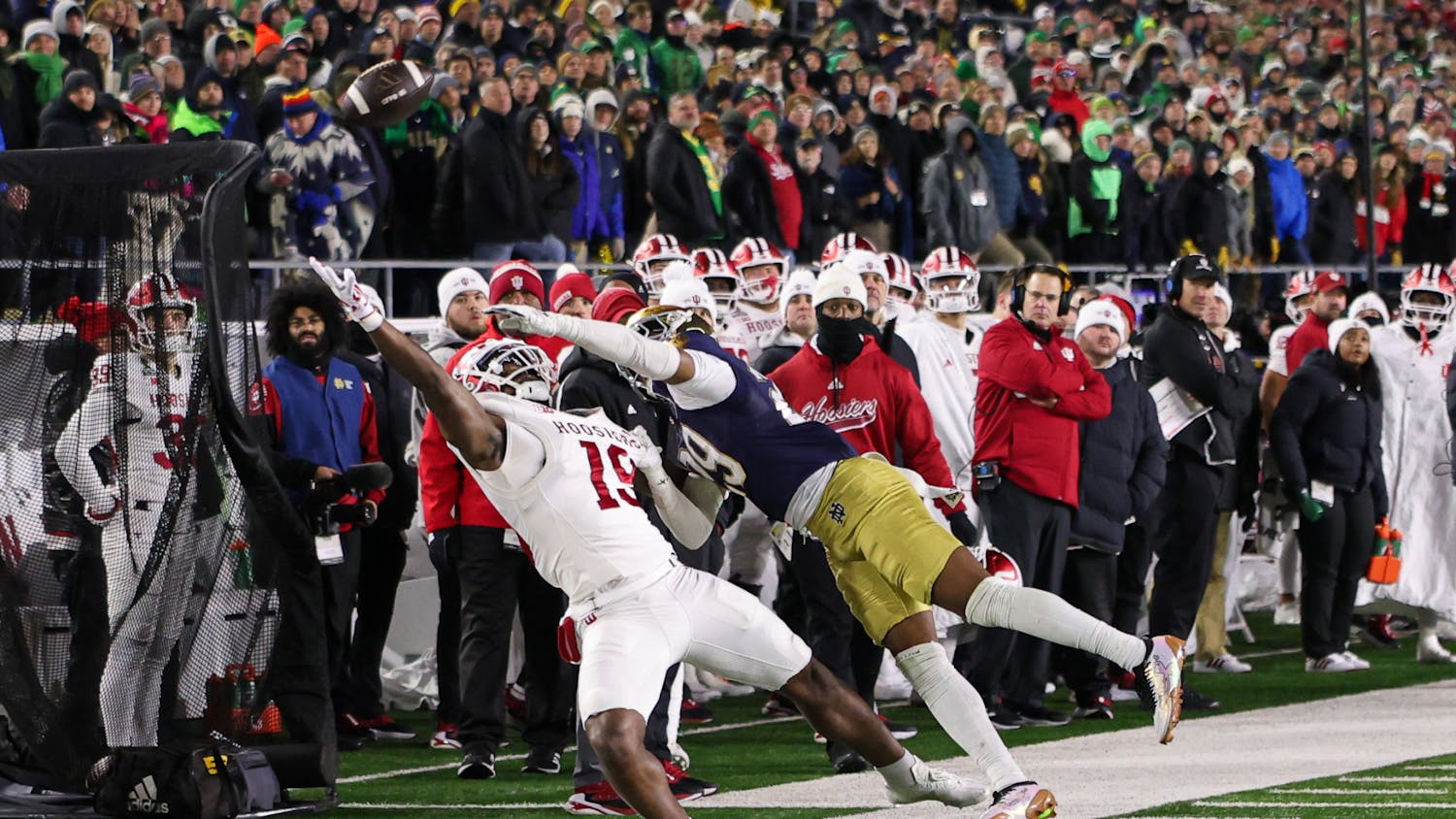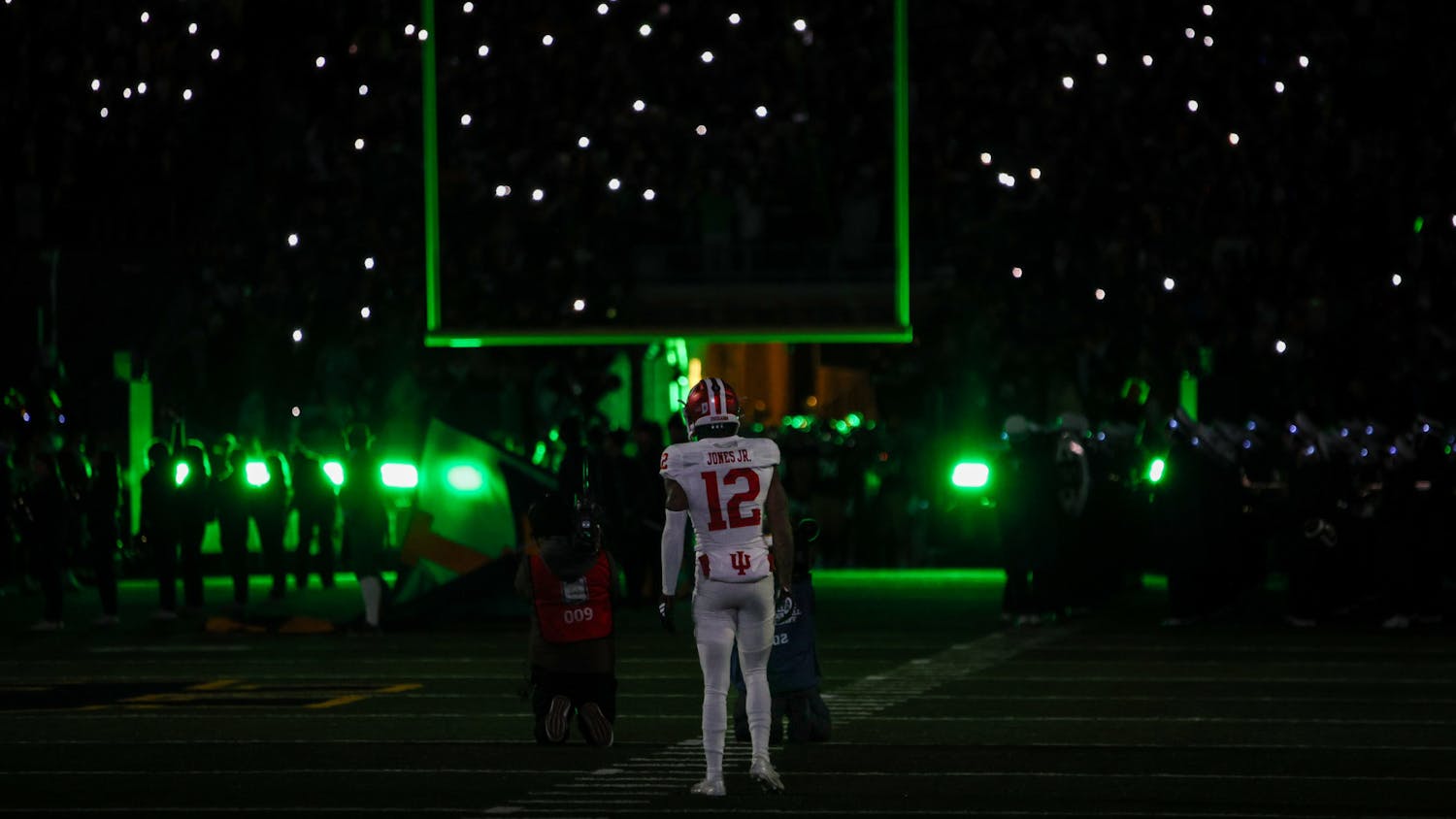Indiana’s offense begged for a big play as it huddled on the sideline.
“You’re going to have to show me something,” wide receiver DJ Matthews told third-string running back Chris Childers.
It was early in the second quarter of Indiana's game against Michigan State, and the Hoosiers were trailing 7-6 — but still hoping for a signature win over the No. 10 Spartans. The team needed a spark, and despite having only seven carries on the season, Childers was ready to seize the opportunity.
“I’m going to show you,” Childers responded to Matthews.
On the first play of the drive on Indiana’s 22-yard line, Tuttle took the shotgun snap and stuck the ball in Childers’ stomach. Childers waited patiently for tight end Peyton Hendershot to pull across the offensive line, put his hand on Hendershot’s back, then burst through the hole for a 25-yard gain.
“You can never go wrong following Peyton Hendershot,” Childers said.
Indiana’s offensive struggles have been no secret in 2021. Through seven games, Indiana ranks 121st out of 130 teams in total offense. Even after Childers’ run, Indiana would settle for its third field goal in as many trips to the red zone — contributing to its 92nd national rank in red zone offense.
But Childers’ scamper impressed Indiana head coach Tom Allen. At 5.7 yards per carry, Allen knows Childers will make the most of his limited touches.
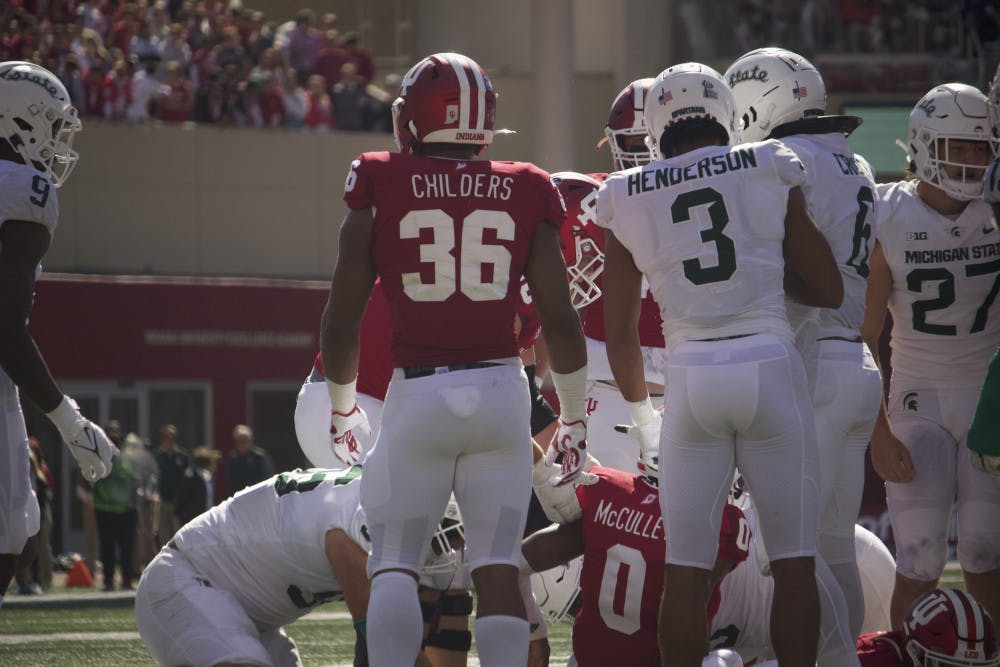
"It's awesome to see a guy like that be able to come here and buy in and work hard and believe in himself,” Allen said.
While Childers sits third on the depth chart behind Stephen Carr and Davion Ervin-Poindexter, he has begun to carve out a necessary role in Indiana’s offense. Running backs coach Deland McCullough said Childers was trending up on the depth chart even before the transfers of Sampson James and Tim Baldwin Jr. and the season-ending injury to David Ellis.
Childers combines strength and speed, built from his days as a multi-sport athlete in high school, and prides himself on the ability to pick up blitzes in the backfield. He transferred to Indiana after appearing in 19 games at Indiana State, but his football talents aren't the only intriguing thing about him -- Childers has his eyes on the stars.
“I just wanted to prove that I’m a Big Ten running back,” Childers said. “I’ve been doing that.”
***
Chris Childers was surrounded by empty plates in the cafeteria at St. Rita High School in Chicago. It was wrestling season, and Childers’ teammates had aspirations to wrestle in college. They were cutting weight, starving themselves to remain in the lowest weight class.
Childers joined the wrestling team to occupy the football offseason, but didn’t adhere to every wrestling norm. As a high school running back who dreamed of playing in the NFL, Childers’ plate looked a bit different.
“Dude I’m not doing that,” Childers told his teammates. “I’m loading my plate up.”
Childers admits this might not have been the smartest decision. He usually wrestled in the 195-pound weight class, but some days a second helping at lunch pushed him over the edge, weighing in at 196 pounds on match day.
He was forced to wrestle in the 220-pound weight class against high school defensive linemen who cut weight from their original 260 pounds. Childers lost every match in the 220-pound division, but that didn’t bother him. It built Childers into who he is today — a 220-pound Big Ten running back.
“I don’t really care who’s in front of me,” Childers said. “I go get it.”
Wrestling imposed a mentality of relentless physicality in Childers as a freshman in high school. He thinks this gave him an advantage over other freshmen that weren’t naturally physical when starting college football careers.
Childers once had a conversation with Allen about wrestling, and he could tell his coach was immediately fired up. As a high school wrestler himself, Allen loves to talk wrestling with his players and relate the physical nature of the two sports.
Wrestling also helped Childers develop strong pass-blocking traits. He now prides himself on picking up blitzes and keeping the quarterback on his feet, thanks to skills learned through wrestling in high school.
“You’re hand fighting a lot, head butting, and it’s a lot of the same things,” Childers said. “Swiping hands, it carries over and correlates greatly.”
Pairing physicality with speed, Childers also ran track in the spring to stay busy. He was a sprinter, entering in any event from 100 and 200-meter races to the 4x100 and 4x200-meter relays. He even ran the 800 once, but told his high school coach to never enter him in that event again.
Childers gained necessary speed to play running back thanks to his track days, but he said track also taught him proper running mechanics that have helped him stay healthy, avoiding hamstring and other leg injuries.
Childers rounded out his high school career with a first-team all-conference selection in the highly-competitive Chicago Catholic League. He starred as a linebacker for two seasons, and as a junior, played more of a fullback role in St. Rita’s two-tailback formation.
Childers capitalized on earning a featured role as a senior and finished his high school career rushing for 1,512 rushing yards and 20 touchdowns. This generated interest from schools such as Syracuse, Minnesota, Notre Dame and Vanderbilt, but during his recruitment, he felt like the backup option. The only school to offer him was Indiana State.
After not getting the desired offers out of high school, Childers pushed forward with an edge. He said he is not bitter over his recruitment, but he wanted to prove that he is a Big Ten running back.
Childers saw the field sparingly for the Sycamores as a freshman and totaled 34 carries for 110 and three touchdowns as a sophomore.
Here's a look at the Chris Childers touchdown. Trees with 132 rushing yards so far -- Childers with nine. #MarchOn | #LeaveNoDoubt pic.twitter.com/p3nJqjNI6T
— Indiana State Football (@IndStFB) September 14, 2019
After three semesters at Indiana State, he sat down with head coach Curt Mallory — the son of former Indiana head coach Bill Mallory — and said it was time to transfer. Nothing personal.
“I miss the guy,” Childers said. “He took care of me really well, and he was one of the only coaches that gave me an opportunity.”
Childers was upset about leaving. That was his first football family, and he still keeps in touch with many former teammates. But academic aspirations and the motivation to prove past recruiters wrong by playing in the Big Ten made transferring the best decision for him.
Childers reached out to the Indiana coaching staff, and said he was interested in joining the team as a walk-on. Allen was happy to have him.
“He wanted to come here,” Allen said. “He believed he could play here.”
***
Football wasn’t the only reason Childers transferred to Indiana. He wanted to work for NASA.
As a freshman at Indiana State, Childers majored in business. He took an accounting class to follow in his father’s footsteps, but didn’t like it. His next major was psychology — but nope, not that either. He switched to mechanical engineering and fell in love with working with electronics.
This sparked an interest in the aerospace field, but Indiana State didn’t offer those classes. At the time, Childers’ goal was to take football as far as he could, then go work at NASA.
“I’m a big science guy,” Childers said. “I love outer space.”
Childers arrived at Indiana for the spring semester in 2020 after attending Indiana State for three semesters. Enrolling at Indiana as a physics major, Childers laid his two dreams out in front of him: science and football.
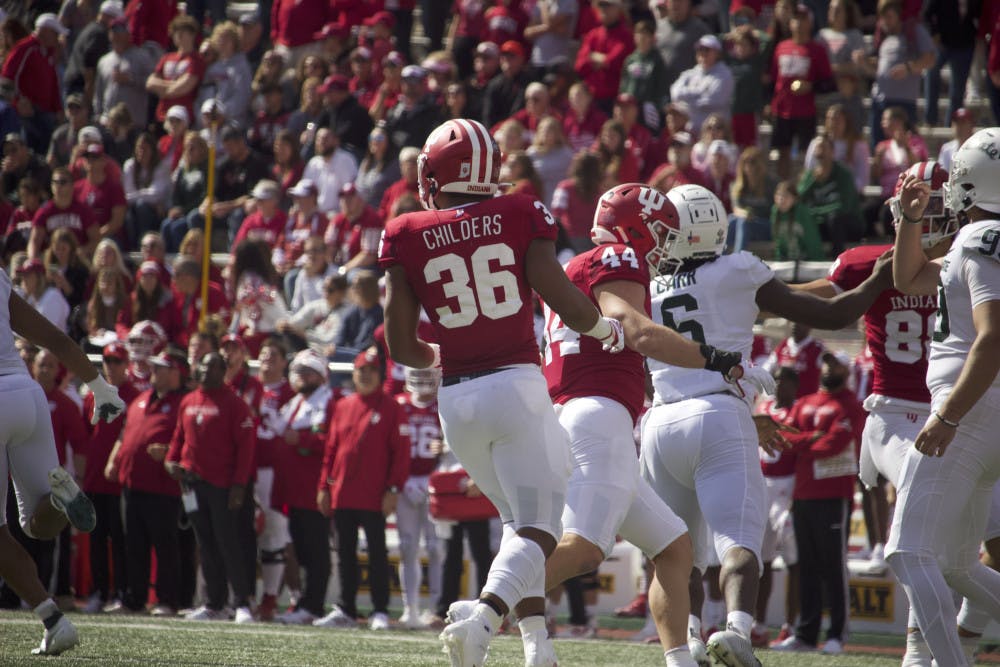
Due to transfer rules at the time, Childers was forced to sit out during the 2020 season. Childers said “doing things that others don’t so you get the results others won’t,” was the prevailing mindset as a member of the scout team. This meant getting in the weight room early and leaving last.
Allen preaches the idea of falling in love with the boredom of consistency, and Childers bought in. Since he couldn’t make a direct impact on the field, he also focused on making the rest of the team better. He didn’t worry about impressing coaches, but naturally, he became a player who stood out at practice.
McCullough said he saw notable strides in the way Childers improved his footwork, suddenness, change of direction and hand placement when blocking. Gaining yards after contact was always Childers’ strength, but he began to take things to the next level at Indiana.
“I’ve always been impressed with the way he runs,” McCullough said. “He finds holes, he’s very dependable.”
Childers was named special teams scout player of the year in 2020 and added an offensive scout team player of the week honor to his name leading up to Indiana’s win over Penn State.
He didn’t travel with the team during the 2020 season, giving him more time to focus on his academic goals. Taking math classes online due to COVID-19 wasn’t fun, but Childers pressed on.
He enrolled in Calculus Two and a 500-level physics class during the 2021 fall semester. Due to his increased role on Indiana’s offense, balancing difficult science classes and football became too much. Childers dropped physics and is now a liberal studies major, but still isn’t ready to give up his NFL dreams.
And McCullough might be the perfect coach to guide him along the way. McCullough played two seasons in the NFL for the Cincinnati Bengals and Philadelphia Eagles before coaching the Kansas City Chiefs for three seasons where he won the Super Bowl.
Childers said he thinks Indiana’s running backs compose one of the best position groups on the team because they are coached professionally. Everything from warmups to practice drills to reads in the game are what McCullough taught in the NFL, Childers said.
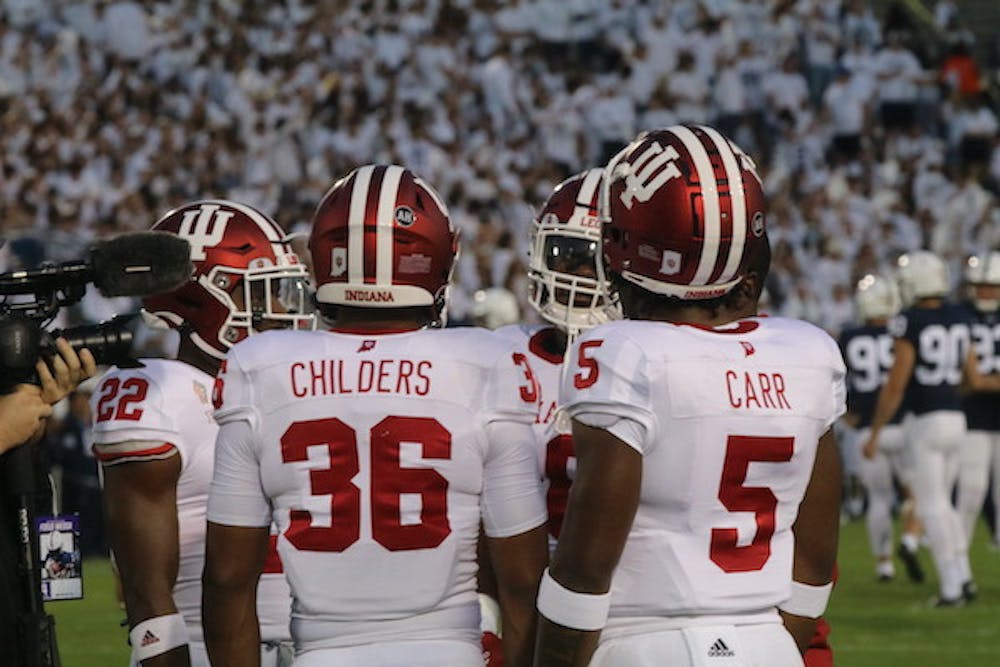
“We’ll be in a meeting and [McCullough will] be like, ‘Hey, this route, you’ve got to learn how to run this because this is what they run in the NFL,’” Childers said.
Childers said every team has a player that can run the ball well, but he believes the pride he takes in pass blocking and protecting the quarterback separates him from others. He plans to go to graduate school to pursue his dreams of working for NASA, but not until he takes football as far as he can.
And now, he’s motivated by his future family. Childers found out his girlfriend was pregnant six months ago. He admits he was scared at first, but now, excitement is the prevailing feeling.
“I couldn’t be happier,” Childers said. “Now I’m doing everything for my family.”
***
Written on the wall in Childers’ room are the words “defeat your yesterday.”
This is Childers’ motto. To Childers, it means to keep stacking and building. He knows it’s cliche, but he strives to get 1 percent better every day — whether that’s the way he plays, the way he eats or even studies.
These words have pushed him to go from limited touches at Indiana State to walking on at Indiana. They motivated him to pursue a career in aerospace engineering while also playing collegiate football. His motto has allowed him to not get caught up in the monotonous routine of lifts and practice every day.
Childers’ yesterday was playing on Indiana’s scout team, but he’s already defeated that. His today is playing a meaningful role in Indiana’s backfield — both as a tough runner when called upon and as a gritty pass blocker.
And now, he’s working to defeat that with his sights set on a tomorrow with the NFL or NASA.
